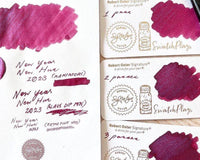There’s a special place in a writer’s stationery collection for fountain pens. Yes, ballpoint pens and rollerball pens perform well and are extremely convenient, but there’s just something about the smooth performance of a fountain pen that really elevates the writing experience. However, its mechanism also comes with more complexity, which is why more things can go wrong. You may have experienced wanting to write with your fountain pen, only to be frustrated that it just won’t start or keeps skipping. Here are a few things you can do to get your pen writing again.

Check if there’s enough ink
The first thing you should do if your pen isn’t writing is to check if there’s enough ink. Sometimes we don’t notice how just long we’ve been writing with our pens, and it ends up running out of ink before we realize it. Simply remove the grip section from the barrel and inspect whether your cartridge or converter is out of ink. If the reservoir is empty, then it’s time to refill your fountain pen and try writing again. If it is still full of ink, then it’s time to try something different.
Wet the nib
Another reason why your pen might not be writing is because of dried ink. This can happen especially if you haven’t written with your pen in a while. To remedy this, wet the nib with tap or distilled water. This should fix any hard starts you are experiencing. After wetting the nib, your ink may appear lighter than its original color at first. Don’t worry as it will eventually return to its full saturation. This method will fix any dried nib around your nib and part of the feed that is exposed.
Clean your pen
If your pen still won’t write after trying the first two methods, then it might be time to disassemble your pen and give it a more thorough cleaning. Using such writing tools on a regular basis requires us to observe best practices in fountain pen cleaning and maintenance to keep them working properly.
Fountain pens have various parts that can be obstructed, whether by pieces of paper, ink, or debris. The nib is particularly susceptible to this as it is the part of the fountain pen that is exposed. It is constantly writing on surfaces, which means that paper fibers and dried ink can build up between the tines. Dried ink can also clog the feed, especially if you are using shimmering or sheening inks.
Clean your pen out by doing a thorough flushing and soak. This should work in most cases. If not, then we inspect the pen’s other parts.
Check the nib and feed alignment
The nib and feed can sometimes become misaligned. This may happen when you reassemble your pen and the nib and the feed are not precisely lined up to allow for ink flow. Checking the nib and feed for alignment isn’t difficult and requires only a simple magnifying glass or a loupe to make it easier. Look at the breather hole of your nib to see if the feed’s slit is centered. If it is out of alignment, you can gently push the nib and feed into place. It is important that the bottom of the nib and the top of the feed are flush and that the tines are aligned.
And there you have it! Whether you own a Pilot a LAMY or even a luxury Montblanc fountain pen, there will always be a way to fix a pen that doesn’t want to write. If your pen still refuses to write even after trying these methods, then it is best to take it to a nibmeister for closer inspection.
Happy writing!
Written by EndlessPens Blogger Ramona Kabigting







